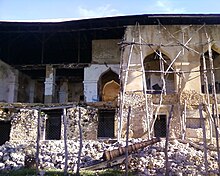Kilwa Kivinje
Kilwa Kivinje is a coastal city on the Indian Ocean in Tanzania . It is located in the Lindi region and has 13,374 inhabitants (2002 census).
history
The city emerged as an Arab settlement after the destruction of large parts of Kilwa Kisiwani, about 15 km south, by the Portuguese in the 17th century and the subsequent decline of Kilwa Kisiwani.
At first there was only a small settlement here, but in the early 19th century the place with its old entrance way into the interior gained a certain importance for the Arab traders, who (compared to other trading establishments on the East African coast) have a rather small market for Slaves and ivory entertained. The sultans of Oman and later Zanzibar had their liwali (governor) for the southern part of the Tanzanian coast here.
At the beginning of the 19th century, the name Kilwa Kivinje (from kiswahili "Kilwa near the casuarina trees") was used to distinguish it from Kilwa Kisiwani ("Kilwa on the island").
In 1888 the German-East African Society tried to take control of the previously Zanzibari coastal strip and thus also Kilwa, which initially succeeded in Kilwa on August 16. Which then of Pangani outgoing uprising of the East African coast population (the so-called. " Arab uprising ") spread in December finally to Kilwa from. The two German employees of the company were attacked on September 22, 1888 and were killed together with ten Askaris . The slave traders in this area were particularly active during the uprising. At the beginning of May 1890 Kilwa Kivinje was taken by the "Wissmanntruppe" (a German colonial force under Hermann von Wissmann ). A district headquarters for the entire southern region of the German East Africa colony , the Kilwa district, was later set up here.
During the Maji Maji uprising in August 1904, Kilwa Kivinje was again the scene of fighting. From the small cruiser SMS Bussard a detachment of the navy or the imperial protection force was detached to protect the coastal station and fight the insurgents.
At the time of German colonial rule, Kilwa Kivinje had a post office, a telegraph station, a customs office and around 4,000 residents. The city's port developed, but lagged behind the growth rates of the other ports in German East Africa. Shortly before the outbreak of World War I , imports and exports had just exceeded the 1 million Reichsmark level. The main exports were cotton, oil fruits such as sesame and copra, liana rubber, wax and some ivory. When imported, the textile goods amounted to half of the total value, plus rice and metal goods.
Kilwa Kivinje initially remained the administrative seat of the region even after colonial rule passed to Great Britain , but in 1956 the British colonial authorities decided to relocate the district administration to Kilwa Masoko, which had previously been insignificant .
present
For many years the city has been in a kind of "deep sleep", and the old German colonial buildings (market hall, customs house, boma ) have fallen into disrepair. There is a main shopping street with a multi-storey former shop building.
Tourists rarely come here on day trips from Kilwa Masoko. Recently, however, there has been discussion about including the old town in the UNESCO World Heritage Site of Kilwa Kisiwani and Songo Mnara and thus revitalizing it.
Individual evidence
- ↑ Reichstag files 1888/89, 7th edition, Vol. 121, Attachment 41: Report of the Reichsregierung
- ↑ a b Kilwa-Kiwindsche. In: Heinrich Schnee (Ed.): German Colonial Lexicon. Quelle & Meyer, Leipzig 1920, Volume II, p. 300 ( online ).
- ^ Bernhard Buchholz: Experiences of the machinist Otto Gehring from SMS "Bussard" during the Maji-Maji uprising in German East Africa. Without location information. Without a time. Pages 1-2. ( online )
- ↑ Status report of the World Heritage Committee, 2006 (PDF; 742 kB), p. 62
Coordinates: 8 ° 45 ′ S , 39 ° 25 ′ E
